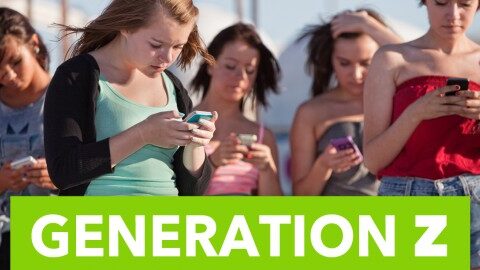Raise your hand if you’re tired of hearing about the Millennials.
Employers have been trying to figure out how to deal with Millennials since they entered the work force about 15 years ago and healthcare has been bracing for the changes that they might bring as consumers. Now, it’s time to start preparing for the next generation, who will comprise 40% of all consumers by 2020: Generation Z.
Members of Gen Z were born between 1995 and 2015 and have been parented by Gen X’ers and the older Millennials. They are digital natives, born after the internet was popularized and raised on smart phones. With the youngest members of Gen Z celebrating their first birthday this year, it will be quite some time until we feel the full impact of this generation. However, extensive research has already been done to reveal the attitudes and behaviors of the older half of Gen Z (who go up to 21 years old), many of whom are in or approaching college or about to enter the workforce.
While Gen Z won’t dominate healthcare use in the near future, smart brands are taking notice and thinking about engagement strategies now, especially as the focus on wellness creates more relevance with younger audiences. Below, we’ve outlined five important Gen Z insights for healthcare organizations:
- Learn how to tell a quick, visual, and authentic story. Researchers say that goldfish have a longer attention span than Gen Z (6-8 seconds). Capture their attention with bite-sized content delivered in a fun way. Think in pictures, catchphrases and 8 second (or less!) video clips. An example of a brand that is doing it well is shoe company Sperry Top-Sider, which posts videos and still photos of sailing, kayaking, and cliff diving in its “Odysseys Await” campaign to draw in Gen Z and appeal to their sense of adventure. Gen Z prefers visual content. One only needs to look at the use of emojis to realize that words are secondary to images for this generation. This is supported by a recent survey that showed that Gen Z’s favorite social networks are Snapchat and YouTube, with 93% of Gen Z logging onto YouTube at least once a week. Their top reasons for using YouTube include “Following Social Media Influencers” (48%) and “Learning New Information” (42%). On Snapchat, Gen Z flocks to Gen X’er DJ Khaled, who shares a very real glimpse into his life with brief videos, focused on his often comical “keys to success.” (Khaled famously documented getting lost on a jet ski at night – “the key is to make it. The key is to never give up…The key is not to drive your jet ski in the dark.”).http://https://youtu.be/U3POE3iTD6o
- Let them be part of your story. A 2015 study found that Gen Z doesn’t want to simply consume entertainment – they want to help create it. Over 25% post original video on a weekly basis, while 65% enjoy creating and sharing content on social media. For a brand, this might translate into a contest that encourages followers to submit pictures, video or a story. Sperry Top-Sider’s stories in its Odyssey’s Await campaign are written by real adventurers telling the story from their lens. Letting Gen Z be part of your brand’s story also extends to seeking their feedback and helping determine solutions, which could include bringing in community members to talk about how to tackle the most pressing health issues or how to design a new hospital.
- They value quality – and are willing to pay for it (Hallelujah!). Gen Z is focused on value, but they understand that quality can come at a premium price. The 2015 Nielson Global Health and Wellness report highlighted that Gen Z’ers were far more willing to pay a premium for functional foods that reduce disease risk or promote good health and for socially/environmentally responsible foods than other respondents. Focus groups also revealed that the more expensive something is, the more Gen Z is willing to pay to ensure they’re not being cheated, often leading them to buy from physical stores and trusted brand web sites. For healthcare organizations, this means tools like Wisconsin’s PricePoint, which allows consumers to compare cost and quality across hospitals for various services, may become even more valuable. It also means that it is important to think about how your organization is packaging its quality information to share in a consumer-friendly way.
- They introduce new technologies to their parents. The parents of Gen Z are still relatively youthful and are likely pretty tech-savvy. However, as they come of age, members of Gen Z are the technology leaders at home, showing their parents how to use apps and programs. They are a conduit to their parents who are heavier users of healthcare. It’s Gen Z that will inspire demand for new technology, such as the latest wearable device or a new app, and services, such as telemedicine, and teach their parents how to use it (as long as it doesn’t make them join Snapchat!).
- They expect you to get real. Gen Z’s value of authenticity extends to its preference for brands working with real people, not celebrities. Research shows that Gen Z’ers look to their friend circle first and social media influencers second to tell them about new products. They want to see these products being used in realistic situations and 63% would try a product or brand recommended by a YouTube star vs. 48% by a TV/movie star (good news for your budget!). Identify influencers that may be relevant to your organization and

Source: http://www.express.co.uk/life-style/life/542301/Zoella-Zoe-Sugg-facts develop strategies for engaging them with unique brand experiences (for instance, a behind the scenes OR tour or the opportunity to see new technology in action).
If you were tired of hearing about the Millennials, the good news is that Gen Z will soon dominate the conversation. At 80 million strong with spending power at close to $200 billion annually (when you factor in their influence on parental or household purchases), it’s time start thinking about how to increase relevance and engagement now to build affinity for your brand.

